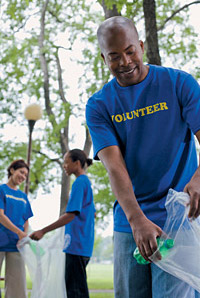Various definitions of what constitutes and what makes a profession have been described over the years. One definition includes that a profession must have specialized knowledge and a dedication to selfless service.
Though each definition has differences, most definitions include the trait of altruism – putting others before self. If altruism truly is an essential trait to be considered a profession, then what must we do, both as individuals and collectively, in order to satisfy the condition of altruism and ensure we are a profession? Here are a few suggestions to consider as it relates to the field of chiropractic.
The Altruistic Perspective
Altruism is when we put others before ourselves and we think and act for the greater good of society. This includes focusing on the best interests of our patients and community, instead of personal or financial gain as our primary focus. This does not mean to say that we should not get paid for what we do, give our services away or discount the value of what we offer. It does mean that our decisions and actions in practice and our personal lives should be led by what is best for our patients and the community, instead of primarily for reasons of self-gain.
 Altruism is one of the essential ingredients to gaining trust of individuals and the public; and trust is an essential component to having authority bestowed upon us. Although I have heard the term cultural authority used in recent chiropractic discussions, Paul Starr, author of The Transformation of American Medicine, developed this term to mean "that particular definitions of reality and judgments of meaning and value will prevail as valid and true" in order to distinguish this term from the term social authority.
Altruism is one of the essential ingredients to gaining trust of individuals and the public; and trust is an essential component to having authority bestowed upon us. Although I have heard the term cultural authority used in recent chiropractic discussions, Paul Starr, author of The Transformation of American Medicine, developed this term to mean "that particular definitions of reality and judgments of meaning and value will prevail as valid and true" in order to distinguish this term from the term social authority.
Some in chiropractic may be using the term cultural authority incorrectly to imply something we can declare, as if we can somehow work on a strategy to demonstrate "cultural authority" or declare that we are legitimate and thereby somehow gain authority. That use would be inappropriate. Starr warns that authority cannot be gained through invention or elaboration of "credentials, sciences, and codes of ethics in bids for recognition." Instead, authority is something that is earned over time; a result of our actions.
By gaining trust through mastery of our body of knowledge, autonomy and altruism, society would then bestow power and authority to the chiropractic profession. Individually and collectively, we must act in a manner that is trustworthy in order to gain the trust of patients and society. Altruism is one of the vital qualities in which each of us can participate in and contribute to, being part of a profession.
Chiropractic Altruism in Action
How can a doctor of chiropractic be more aware of and involved in altruistic activities? Here are some thoughts and suggestions for you to consider. First, reflect on your daily practice actions. Are you doing everything possible to help your patients achieve maximum health? What about helping community organizations? What about helping on a society or policy level? As health care providers, we have the opportunity to influence many, so we should consider actions of altruism on many different levels. For example:
Promote and protect public health – The only thing that may be better than helping someone in pain is preventing the pain from ever happening in the first place. Are you only focusing on those who are already injured or are you also working to help prevent injury and disease? Are you offering a valid, evidence-based education in your practice? What are you doing to maximize your patients' health? Are you including strengthening, stretching, posture, modified activities to prevent injury / disease, healthy dietary advice, smoking cessation, stress management, healthy levels of physical activity, and other public health-associated items?
If you are not comfortable with some of these health strategies, then you can – and should – learn more about them. Consider joining a national or local public health organization, take postgraduate courses and/or enroll in public health courses at your local college. If you do not wish to or are unable to provide some of these services, you can collaborate with another health care provider in your area who offers these services.
Collaborate with other health care professionals and local groups – Are you offering your expertise to those who could collaborate with you for your patients' best interest? Consider providing complimentary education sessions for health care providers or local support groups for pregnant women (e.g., breast-feeding, healthy birth practices), neurological and musculoskeletal injury prevention (e.g., reducing concussion in sports, encouraging fitness programs), best practices to return to work (e.g., strengthening, focus on function) or other health activities so you can collaborate with local providers.
Reach out to organizations and your community – Are you providing your knowledge as an expert in neuromusculoskeletal care to local institutions and organizations? Are you offering instructional presentations on the importance of injury prevention? Consider contacting local business owners to offer seminars on work injury prevention, fall prevention in the local nursing home, protecting adolescents from concussion injury in sports, or other areas within your interests.
Consider becoming involved with local coalitions or health boards to increase physical activity, improve school lunch programs, support bike helmet use to prevent head trauma, plan walking / biking trails, violence-prevention programs, and other community-level activities. Consider becoming involved with a local hospital board to improve quality of care and safety outcomes. Be sure to focus on improving the health of the organization in an altruistic way, as these are not supposed to be patient-recruitment sessions.
Influence health policy on a societal level – Are you advocating for better health policies, such as better access to health care, fighting for social justice issues, promoting health care for the underserved in your state, and advocating policies that support providing cost-effective management? Consider communicating with your regional politicians regarding important health issues. This could be a simple letter or phone call, or you can become more involved by participating on policy committees or lobbying.
You have the ability to influence policies and laws that can help to protect the health of the public through healthy actions, disease prevention and disease control. The amount and level of your dedication are up to you.
Hidden Benefits of Altruism
Altruism is not supposed to be about you. But for argument's sake, what could you gain from being altruistic? By thinking and acting in an altruistic way, you are showing the world that as a doctor of chiropractic you demonstrate compassion and professionalism. You enlarge your circle of influence. You gain prestige and trust from your patients, community, and society. Ultimately, your community and environment become a better place for you and for your family and friends. And, you gain satisfaction of knowing you are doing the right thing. These benefits are priceless, especially since they cannot be bought. The value you gain is worth much more than what you have given up.
Altruism is a primary trait of a profession. Without it, we would simply become a trade organization and cease to exist as a profession. Consider committing yourself to doing one more selfless act per week beyond what you normally do. Pick something that you are passionate about, consider expanding your circles of influence, and make a difference by helping others. Just imagine: If we joined together as a profession and committed to collective altruism, the world really would be a better place.
The altruistic activities mentioned here are a natural fit for chiropractic and public health. Chiropractic has much to offer in the field of public health and public health fits nicely within the domain of altruism. Consider joining your local public health chapter and/or the Chiropractic Health Care section (CHC) of the American Public Health Association (APHA). In the CHC-APHA, we are focused on action for the better good of others.
Resources
- Starr P. The Social Transformation of American Medicine: The Rise of a Sovereign Profession and the Making of Vast Industry. New York, USA: Basic Books, 1982.
- Johnson C, Green BN. Public health, wellness, prevention, and health promotion: considering the role of chiropractic and determinants of health. J Manip Physiol Ther, 2009 Jul-Aug;32(6):405-12.
- Johnson C, Baird R, Dougherty PE, Globe G, Green BN, et al. Chiropractic and public health: current state and future vision. J Manip Physiol Ther, 2008 Jul-Aug;31(6):397-410.
Click here for previous articles by Rand Baird, DC, MPH, FICA, FICC.
Dr. Claire Johnson is a professor at National University of Health Sciences and editor in chief of JMPT, the Journal of Chiropractic Medicine and the Journal of Chiropractic Humanities. She also serves as the communications chair for the American Public Health Association (APHA) Chiropractic Health Care (CHC) section.





